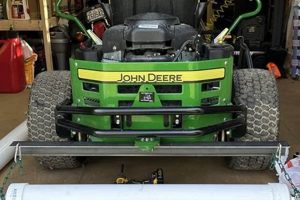A do-it-yourself amplifier package comprises all the necessary components and instructions required to construct a functional audio amplifier. These sets typically include a printed circuit board (PCB), electronic components such as resistors, capacitors, transistors or integrated circuits, and a detailed assembly manual. The aim is to provide an accessible and educational experience for individuals interested in electronics and audio technology, facilitating the building of a personalized audio amplification device.
The value of assembling an amplifier in this manner stems from several advantages. Constructing such a device provides a practical understanding of electronic circuit design and function. It also promotes skill development in soldering, component identification, and troubleshooting. Furthermore, completing the project can result in a customized audio solution tailored to specific needs or preferences, offering a potentially cost-effective alternative to purchasing pre-built amplifiers. The popularity of these projects extends across various user levels, from hobbyists and students to seasoned electronics enthusiasts.
The subsequent sections will explore the different types of these packages available, the factors to consider when selecting one, and a step-by-step guide to the assembly process, providing a thorough overview for those considering undertaking this project.
DIY Amp Kit Assembly
Successful construction of an audio amplifier requires careful attention to detail and adherence to best practices. The following guidelines aim to enhance the assembly process, minimizing potential errors and ensuring optimal performance.
Tip 1: Component Identification: Prior to soldering, meticulously identify each component using the parts list and schematic diagram provided. Incorrect placement can lead to circuit malfunction or damage.
Tip 2: Soldering Technique: Employ a clean soldering iron and high-quality solder. Ensure proper heating of both the component lead and the PCB pad, creating a secure and electrically sound connection. Avoid excessive solder, which can cause shorts.
Tip 3: Polarity Awareness: Electrolytic capacitors, diodes, and transistors have specific polarity. Refer to the schematic to confirm correct orientation before soldering. Reversed polarity can result in component failure.
Tip 4: Cleanliness: Regularly clean the PCB with isopropyl alcohol to remove flux residue. This improves insulation and reduces the risk of corrosion over time.
Tip 5: Voltage Verification: Before connecting audio equipment, verify the amplifier’s output voltage and power supply voltage. Ensure they align with the specifications of the connected devices to prevent damage.
Tip 6: Grounding Considerations: Proper grounding is crucial for minimizing noise and hum. Ensure a solid ground connection between the amplifier and the power supply, and adhere to the grounding scheme outlined in the instructions.
Tip 7: Testing and Troubleshooting: After assembly, systematically test the amplifier’s functionality. Use an oscilloscope or multimeter to diagnose any issues, consulting the schematic and troubleshooting guides for assistance.
By implementing these strategies, individuals can significantly increase the likelihood of a successful outcome, fostering a deeper understanding of electronics principles and gaining a functional audio amplifier.
The subsequent section will delve into advanced modifications and customization options, enabling further enhancement of the constructed amplifier’s performance and features.
1. Circuit Design
Circuit design forms the foundational blueprint for any do-it-yourself amplifier package. It dictates the amplifier’s performance characteristics, including gain, frequency response, and distortion levels. A well-designed circuit ensures stable and predictable operation, whereas a poorly designed one can lead to instability, poor sound quality, or even component failure.
- Amplification Stage Design
The amplification stage determines the amplifier’s gain and output power. Different circuit topologies, such as common-emitter or common-collector configurations for transistors, offer varying characteristics in terms of gain, input impedance, and output impedance. Selecting the appropriate topology is critical for achieving the desired amplifier performance. For instance, a high-gain amplifier requires a different design approach than a low-distortion amplifier. Incorrect implementation can lead to unwanted oscillations or clipping of the audio signal.
- Bias Network Design
The bias network establishes the operating point of active devices like transistors or vacuum tubes. Proper biasing ensures that the active devices operate within their linear region, minimizing distortion. Incorrect biasing can lead to crossover distortion or saturation, both of which negatively impact sound quality. Bias stability, ensuring the operating point remains consistent despite temperature variations, is also a crucial design consideration.
- Feedback Network Design
Feedback networks are used to stabilize the amplifier, reduce distortion, and improve frequency response. Negative feedback is commonly employed to achieve these goals. The design of the feedback network involves careful selection of resistor and capacitor values to achieve the desired feedback characteristics. Excessive feedback can lead to instability and oscillations, while insufficient feedback may not adequately address distortion or frequency response issues.
- Power Supply Design
The power supply provides the necessary DC voltage and current to power the amplifier circuit. A stable and well-regulated power supply is essential for optimal amplifier performance. Poor power supply design can introduce noise and hum into the audio signal, degrading sound quality. Considerations include transformer selection, rectifier design, and filtering to minimize ripple and ensure a clean DC voltage. A properly sized heat sink is also essential to dissipate heat generated by the power supply components.
In essence, circuit design serves as the fundamental roadmap that determines the functionality and sonic attributes of a DIY amplifier. Every selection, from the amplification stage’s architecture to the power supply’s stability, reverberates through the amplifier’s performance. By understanding and applying the principles of circuit design, individuals can build amplifiers that meet their specific audio requirements.
2. Component Selection
Component selection represents a critical phase in the creation of a functional do-it-yourself amplifier package. The choices made regarding resistors, capacitors, transistors, and integrated circuits directly influence the amplifier’s performance parameters, sonic characte
ristics, and overall reliability. Incorrect component values or substandard quality parts can lead to a diminished signal-to-noise ratio, increased harmonic distortion, or premature failure of the amplifier. For example, substituting a lower-wattage resistor in a high-current section of the amplifier may result in overheating and eventual component burnout. Therefore, careful consideration of component specifications and their impact on circuit behavior is paramount.
The practical implications of component selection extend beyond basic functionality. Higher-quality components, such as film capacitors instead of ceramic capacitors in the audio signal path, can measurably improve the fidelity of the amplified signal. Similarly, selecting transistors or integrated circuits with lower noise figures contributes to a cleaner and more transparent sound output. In power amplifier stages, robust output transistors with adequate heat dissipation capabilities are essential for handling high power levels without distortion or thermal runaway. Furthermore, the choice of potentiometers for volume control and tone adjustments influences the smoothness and precision of these controls, enhancing the user experience. A real-world scenario involves selecting precision resistors for the feedback network to ensure accurate gain setting and minimize distortion.
In summary, diligent component selection constitutes a cornerstone of successful amplifier construction. The correlation between component quality, circuit design, and amplifier performance is undeniable. Understanding the specifications and limitations of each component allows for informed decisions that optimize the amplifier’s sound quality, reliability, and longevity. While cost considerations often play a role, prioritizing quality components in critical circuit sections proves beneficial in the long run, resulting in a superior audio amplification solution.
3. Soldering Technique
Soldering technique is intrinsically linked to the successful assembly and functionality of any do-it-yourself amplifier package. It represents the primary method of creating electrical and mechanical connections between electronic components and the printed circuit board (PCB). A well-executed solder joint ensures reliable current flow and structural integrity, whereas a poorly executed one can lead to intermittent connections, signal degradation, and eventual component failure.
- Joint Formation and Integrity
Proper soldering forms a robust metallurgical bond between the component lead and the PCB pad. This requires heating both surfaces to a sufficient temperature to allow the solder to flow and wet the metal surfaces. Insufficient heating results in a “cold solder joint,” characterized by a dull appearance and weak connection. Conversely, excessive heating can damage components or lift the PCB pad. A properly formed solder joint should exhibit a smooth, shiny, and concave appearance, indicating good wetting and adhesion. In the context of amplifier construction, weak solder joints in the power supply section can cause intermittent operation or even damage to sensitive components due to voltage fluctuations.
- Component Placement and Orientation
Accurate component placement prior to soldering is crucial. Misaligned components can lead to shorts or incorrect circuit functionality. Moreover, the orientation of polarized components, such as electrolytic capacitors and diodes, must be carefully observed. Reversing polarity can cause component failure or damage to the surrounding circuitry. Soldering components in the correct position and orientation requires a stable hand and attention to detail. For example, resistors placed at an angle may interfere with adjacent components, while improperly oriented electrolytic capacitors can explode if subjected to reverse voltage.
- Flux Application and Residue Removal
Flux is a chemical agent used to clean the metal surfaces during soldering, promoting solder flow and wetting. It removes oxides and contaminants that can impede the formation of a strong solder joint. The choice of flux and its application method are important. Excessive flux can leave corrosive residue that degrades circuit performance over time. Therefore, thorough cleaning of the PCB after soldering with isopropyl alcohol or a specialized flux remover is essential. Inadequate flux removal can lead to leakage currents or corrosion of the solder joints, particularly in high-humidity environments.
- Solder Type and Temperature Control
The type of solder used and the soldering iron temperature are critical parameters. Lead-free solder is becoming increasingly common due to environmental regulations, but it requires higher soldering temperatures than traditional lead-based solder. Incorrect temperature settings can result in either cold solder joints or overheating of components. It is essential to select a solder with appropriate melting point and to adjust the soldering iron temperature accordingly. Monitoring the solder flow and appearance during soldering provides valuable feedback on temperature control. Overheated solder can become grainy and brittle, while underheated solder may not flow properly.
In conclusion, mastering soldering technique is paramount for successful “diy amp kit” assembly. Each facet, from joint formation to component placement and flux management, directly impacts the amplifier’s reliability and performance. Adhering to best practices ensures that the amplifier functions as intended and provides years of reliable service.
4. Enclosure Design
Enclosure design constitutes an integral aspect of any do-it-yourself amplifier project. It directly influences thermal management, electromagnetic interference (EMI) shielding, physical protection, and the overall aesthetic appeal of the completed amplifier.
- Thermal Management
Enclosures facilitate heat dissipation from power amplifier components, such as output transistors and heat sinks. Inadequate thermal management can lead to overheating, reduced component lifespan, and potential system failure. Considerations include enclosure material, ventilation, and heat sink mounting. For example, an aluminum enclosure offers superior thermal conductivity compared to a plastic enclosure. Strategic placement of ventilation holes promotes airflow, while proper heat sink mounting ensures efficient heat transfer from the component to the enclosure. An undersized enclosure without adequate ventilation can cause thermal runaway, resulting in permanent damage to the amplifier’s output stage.
- Electromagnetic Interference (EMI) Shielding
Enclosures provide shielding against electromagnetic radiation, both emitted by the amplifier and external sources. Effective EMI shielding minimizes noise and interference in the audio signal. Metal enclosures, particularly those made of steel or aluminum, offer superior EMI shielding compared to plastic enclosures. Proper grounding of the enclosure is essential for maximizing shielding effectiveness. Unshielded amplifiers can be susceptible to interference from radio frequency signals, resulting in audible noise and signal degradation. Careful enclosure design can mitigate these effects, ensuring a cleaner and more robust audio signal.
- Physical Protection
Enclosures protect the internal components of the amplifi
er from physical damage, such as impacts, dust, and moisture. A robust enclosure ensures the longevity and reliability of the amplifier. Considerations include enclosure material, thickness, and construction. For example, a heavy-gauge steel enclosure provides greater protection against physical impacts than a thin plastic enclosure. Sealed enclosures offer protection against dust and moisture, making them suitable for outdoor or industrial environments. Inadequate physical protection can lead to component damage, electrical shorts, and safety hazards. - Aesthetics and Ergonomics
Enclosures contribute to the overall aesthetic appeal and user experience of the amplifier. Considerations include enclosure shape, finish, and control layout. A well-designed enclosure enhances the visual appeal of the amplifier and provides intuitive access to controls. Custom enclosures allow for personalization and creative expression. Poorly designed enclosures can detract from the overall aesthetic and make the amplifier difficult to use. Attention to detail in enclosure design can significantly enhance the user’s perception and enjoyment of the amplifier.
In summary, enclosure design is a multi-faceted consideration that impacts the performance, reliability, and user experience of a DIY amplifier. A well-designed enclosure provides thermal management, EMI shielding, physical protection, and aesthetic appeal, contributing to a superior audio amplification solution.
5. Power Supply
The power supply represents a foundational element in any do-it-yourself amplifier package. It is responsible for converting alternating current (AC) from the mains electricity supply into direct current (DC) required to power the amplifier’s active components. The stability, regulation, and capacity of the power supply directly affect the amplifier’s performance characteristics, sonic integrity, and operational reliability. A poorly designed or inadequately sized power supply can introduce noise, hum, and distortion into the audio signal, limiting the amplifier’s overall capabilities.
- Transformer Selection
The transformer steps down the high-voltage AC from the mains to a lower voltage suitable for the amplifier circuitry. Factors to consider include voltage rating, current capacity, and insulation class. An improperly selected transformer can lead to voltage sags under load, causing clipping and distortion. For example, an amplifier requiring 24V DC at 3A necessitates a transformer capable of providing at least that voltage and current, with a safety margin to account for voltage drops and load variations. Using a transformer with insufficient current capacity may result in overheating and premature failure.
- Rectification and Filtering
The rectification stage converts AC voltage to pulsating DC voltage, typically using diodes in a bridge configuration. The filtering stage smooths out the pulsating DC voltage, reducing ripple and noise. Capacitors are commonly used for filtering. Insufficient filtering can result in audible hum in the amplified signal. For instance, inadequate capacitance in the filter section of a power supply can introduce a 120Hz hum (in countries with a 60Hz mains frequency) into the audio output. Implementing larger filter capacitors or more sophisticated filtering techniques minimizes this issue.
- Voltage Regulation
Voltage regulation maintains a stable DC output voltage despite fluctuations in the AC input voltage or variations in the amplifier’s current draw. Voltage regulators, such as linear regulators or switching regulators, are employed to achieve this. Poor voltage regulation can cause distortion and instability in the amplifier. For example, if the power supply voltage fluctuates significantly with changes in audio signal level, the amplifier’s gain and output power may also fluctuate, resulting in a distorted sound. Using regulated power supplies ensures consistent performance, even under varying operating conditions.
- Protection Circuits
Protection circuits safeguard the power supply and the amplifier circuitry from overvoltage, overcurrent, and short-circuit conditions. Fuses, surge suppressors, and current limiting circuits are commonly used for protection. Without proper protection, a fault in the amplifier or the power supply can lead to catastrophic component failure and potential fire hazards. Implementing overvoltage protection, for instance, prevents damage to sensitive components if the input voltage exceeds the specified limits. Integrating these protective measures enhances the overall safety and reliability of the DIY amplifier.
In conclusion, the power supply is not merely an ancillary component but an integral part of any do-it-yourself amplifier. Its design, component selection, and protection mechanisms directly influence the amplifier’s performance and longevity. A well-engineered power supply ensures clean, stable, and reliable power delivery, enabling the amplifier to operate at its full potential, delivering high-fidelity audio reproduction.
6. Testing Procedures
Testing procedures represent a critical phase in the development and evaluation of any do-it-yourself amplifier. These systematic processes validate the functionality of the constructed amplifier, identify potential faults, and ensure adherence to performance specifications. Rigorous testing confirms the integrity of the assembly process and the effectiveness of the chosen circuit design and components. Without comprehensive testing, potential issues may remain undetected, leading to suboptimal performance, reliability concerns, or even catastrophic failures.
- Visual Inspection and Continuity Testing
A thorough visual inspection verifies correct component placement, orientation, and soldering quality. Continuity testing confirms electrical connections between components and PCB traces. This initial step identifies gross errors such as solder bridges, cold solder joints, and incorrect component installation, which can prevent the amplifier from functioning correctly or cause immediate component damage. For instance, a visual inspection may reveal a missing jumper wire, while continuity testing can identify a short circuit between power supply rails.
- DC Bias Point Verification
Measuring DC voltages at critical points in the circuit, such as transistor base voltages and op-amp outputs, confirms proper biasing of active devices. Incorrect bias points can lead to excessive distortion, reduced gain, or thermal instability. Comparing measured voltages against the expected values from the circuit schematic allows for identification of component value errors or faulty active devices. For example, a significantly lower-than-expected base voltage on a transistor may indicate a shorted resistor or a leaky transistor junction.
- Signal Injection and Gain Measurement
Injecting a known audio signal at the amplifier’s input and measuring the amplified output signal allows for determination of the amplifier’s gain, frequency response, and distortion characteristics. Using a signal generator and an oscilloscope, one can assess the amplifier’s ability to amplify signals accurately across the audio spectrum. Deviations from the expected gain or frequency response can indicate component value errors, impedance mismatches, or parasitic
effects. Excessive harmonic distortion suggests non-linear behavior in the amplifier’s active devices, potentially caused by improper biasing or component saturation. - Stability Testing and Load Verification
Stability testing assesses the amplifier’s susceptibility to oscillations or unwanted feedback loops. Observing the output signal for spurious oscillations or ringing confirms stable operation. Connecting the amplifier to a variety of load impedances, such as different loudspeakers, verifies its ability to drive these loads without distortion or instability. Amplifiers prone to oscillation or distortion under certain load conditions require circuit modifications, such as adding damping resistors or improving power supply decoupling. This ensures reliable performance across a range of operating conditions.
The aforementioned testing procedures are essential for validating the functionality and performance of any “diy amp kit” project. Each test provides valuable insights into the amplifier’s behavior and identifies potential areas for improvement. By systematically conducting these tests and addressing any identified issues, individuals can ensure the construction of a reliable and high-performing audio amplifier.
7. Troubleshooting
The integration of troubleshooting techniques is a necessity within the realm of do-it-yourself amplifier construction. Inherent complexities associated with electronic circuit assembly, component variations, and potential design flaws often manifest as malfunctions requiring systematic diagnosis and remediation. A failure to address these issues effectively can result in a non-functional or underperforming amplifier, undermining the time and resources invested in the project. For instance, an improperly soldered connection may cause intermittent signal loss, while an incorrectly oriented component can lead to complete circuit failure. A structured approach to troubleshooting, utilizing diagnostic tools and a comprehensive understanding of circuit operation, is crucial for rectifying these problems.
Effective troubleshooting of do-it-yourself amplifier packages necessitates a multi-faceted approach. This includes visual inspection for obvious errors, voltage measurements to verify proper biasing, and signal tracing to isolate the source of signal degradation or loss. Real-world scenarios demonstrate the practical application of these techniques. A common issue involves excessive hum, which may be attributable to inadequate grounding, improper shielding, or power supply ripple. Employing an oscilloscope to analyze the signal can pinpoint the source of the hum, allowing for targeted corrective measures. Furthermore, component substitution, particularly with suspect components, is a valuable troubleshooting method. The ability to interpret schematic diagrams and utilize electronic testing equipment is fundamental to successful resolution.
In summary, troubleshooting is not merely an optional addendum but an indispensable component of the do-it-yourself amplifier experience. Challenges arise from the inherent variability in component quality and individual construction techniques. Addressing these challenges requires a systematic approach, a strong foundation in electronics principles, and the ability to effectively utilize diagnostic tools. Proficiency in troubleshooting enables individuals to overcome obstacles, optimize amplifier performance, and derive maximum benefit from their construction efforts.
Frequently Asked Questions
This section addresses common inquiries regarding do-it-yourself amplifier packages, providing clarity on essential aspects of their selection, assembly, and operation.
Question 1: What level of electronics experience is required to successfully assemble a do-it-yourself amplifier kit?
While some kits are designed for beginners with minimal electronics knowledge, others require a more advanced understanding of circuit theory and soldering techniques. It is imperative to carefully assess the kit’s stated skill level and compare it to one’s own expertise to ensure a successful build.
Question 2: What tools are necessary for the construction of such a package?
Essential tools typically include a soldering iron, solder, wire cutters, wire strippers, screwdrivers, pliers, and a multimeter. Depending on the complexity of the kit, additional tools such as a desoldering pump, oscilloscope, or signal generator may be required for testing and troubleshooting.
Question 3: Are all components included in a typical amplifier package, or are additional parts required?
Most kits contain all the necessary electronic components for basic amplifier functionality. However, enclosures, power cords, and interconnect cables are often sold separately and must be acquired independently. A thorough review of the kit’s contents list is advisable to confirm completeness.
Question 4: What safety precautions should be observed during the assembly and testing of an amplifier?
Safety precautions are paramount when working with electronics. Always disconnect the power supply before making any modifications or measurements. Avoid touching exposed wires or components while the amplifier is powered on. Use appropriate eye protection when soldering, and ensure adequate ventilation to avoid inhaling solder fumes.
Question 5: What are the potential benefits of constructing such an amplifier as opposed to purchasing a pre-built unit?
Constructing an amplifier provides hands-on experience in electronics and audio engineering, enhancing understanding of circuit operation. It allows for customization and optimization of the amplifier’s characteristics. Furthermore, it can be a cost-effective alternative to purchasing high-end pre-built amplifiers.
Question 6: What resources are available for troubleshooting problems encountered during assembly or operation?
Many manufacturers provide detailed assembly manuals, schematic diagrams, and online forums for support. Independent electronics forums and online communities also offer troubleshooting assistance. A systematic approach to diagnosis, coupled with a solid understanding of circuit theory, is essential for resolving issues.
These frequently asked questions highlight the key considerations involved in selecting, assembling, and troubleshooting do-it-yourself amplifier packages.
The following section will examine advanced modifications and enhancements that can be implemented to further optimize amplifier performance.
Conclusion
The preceding sections have provided a comprehensive overview of the “diy amp kit,” encompassing its definition, assembly techniques, component selection, circuit design considerations, power supply requirements, testing procedures, and troubleshooting methodologies. The presented information serves to equip individuals with the knowledge necessary to undertake such a project successfully.
The value derived from engaging with a “diy amp kit” extends beyond the creation of a functional audio device. It fosters a deeper understanding of electronic principles and cultivates practical skills applicable to a broad range of technical disciplines. This knowledge, combined with diligent application, leads to a tangible, rewarding result.







